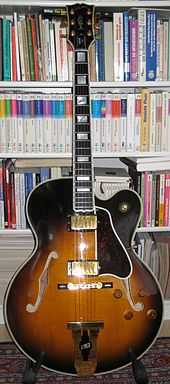Gibson L-5

The Gibson L-5 guitar was first produced in 1922 by Gibson Guitar Corporation, then of Kalamazoo, Michigan, under the direction of master luthier Lloyd Loar, and has been in production ever since. It was considered the premier rhythm guitar in the big band era. It was originally offered as an acoustic instrument, with electric models made available in the 1950s.
The L-5 was the first guitar with f-holes. The L-5 was first produced in a 16" body width and in late 1934 became the 17" body, compared with 18" for the larger Super 400.[1]
Wes Montgomery was a major guitarist commonly associated with the L-5; Gibson eventually produced a custom Montgomery-model L-5 with a single pickup at the neck. Also, the RCA fifties recordings of Elvis Presley feature the sound of Scotty Moore's L-5. Nashville session guitarist Hank Garland, who also recorded acclaimed jazz albums before his near-fatal automobile accident, frequently played an L-5. Contemporary guitarists who have played an L-5 include Tuck Andress from the Tuck and Patti duo, Lee Ritenour, Pat Martino and Jan Akkerman. John Mayer uses one on his cd/DVD Where the Light Is during the main concert and extra features. Eric Clapton used an L-5 to record Reptile and also used one on his cd/DVD One More Car, One More Rider during the songs Reptile, and Somewhere Over The Rainbow.
Early players of the L-5 include Eddie Lang, and Maybelle Carter from The Carter Family, who played her now-famous 1928 model for the majority of her career. Maybelle Carter's L-5 is now kept at the Country Music Hall of Fame in Nashville, Tennessee. Django Reinhardt played an L-5 fitted with a DeArmond pickup during a short tour with Duke Ellington during November 1946.[2] Groucho Marx is seen playing an L-5 in the 1932 Marx Brothers film Horse Feathers.[3] Clint Eastwood featured an L-5 in the 1982 movie Honkytonk Man.

Several different L-5 hollow-body models have appeared over the years, including the L-5 Signature and the L-5 Studio. The ES-5 was the first electric model inspired by the L-5 guitar, first introduced in 1949, and later modified as the Gibson ES-5 Switchmaster. Unlike the L5 which had a solid carved spruce top and solid maple rims and back, the ES5 body was constructed of pressed plywood because Gibson felt that the best tonewoods were not necessary in an electric model. The L-5CES was a direct electric version of the L5, introduced in 1951. These originally used P-90 pickups, but used humbucker pickups from 1958 on. From 1961 through 1969, most production L-5CES guitars featured a "florentine" (sharp) cutaway, replacing the "venetian" (rounded) cutaway design.
Comedian and singer George Gobel had a special version of the Gibson L-5 archtop guitar built in 1958, the "L-5CT" (cutaway, thin body), featuring diminished dimensions of neck scale (24 3/4") and body depth (2 3/8"), befitting his own small stature; and a cherry red finish (for optimal appearance on Gobel's new color TV show). About 45 L-5CT's were produced from 1958 to 1963, making them one of the rarest Gibson models. Most of these were acoustic guitars, although a few were shipped with pickups. The rarest L5 model was a close relative of the L-5CT. It was called the "Crest"*. It was conceived by Gibson employee Andy Nelson (who helped to design the L-5CT) in 1961. It featured the same thinline body of the L-5CT, but the new-for-1961 "florentine" cutaway shape, Super 400-style fretboard inlays, and a unique knight/shield crest design on the headstock. Only six Crests were produced (all in 1961), and no two were identical. [*Gibson produced another model called a "Crest" in 1969-70, but this was a different type of instrument, similar to an ES-330, but with a rosewood body and floating pickups.]
In the 1970s, Gibson produced the L-5S, which was effectively a solid-body version of the L-5 archtop. It was used by Paul Simon and, from 1973–76, by Mark Farner of Grand Funk Railroad (he is seen with the guitar in cover photographs on the band's Caught In the Act live album); and a custom-made single-pickup version was made for Ronnie Wood, who loaned it to Keith Richards for his 1988 tour with the X-Pensive Winos.[4][5]
References
- ↑ Gruhn's Guide To Vintage Guitars, 2nd Edition, pg. 140
- ↑ Django by Michael Dregni, Oxford University Press 2004. Tony Romano, who played with jazz violinist, Joe Venuti, also played the L-5. In fact, he played Eddie Lang's L-5, which was the first produced.
- ↑ Jerry McCulley, The Surprisingly Serious Tale of Comedian Groucho Marx and His Lifelong Quest to Master Guitar.
- ↑ Carter, Walter. "Adventures in Archives: Trail of Stones Leads to Gibson S-1". Gibson Musical Instruments. Retrieved 2008-02-15.
- ↑ Keith Richards & the X-Pensive Winos (1988). Live at the Hollywood Palladium (DVD released 2007). Virgin Records.